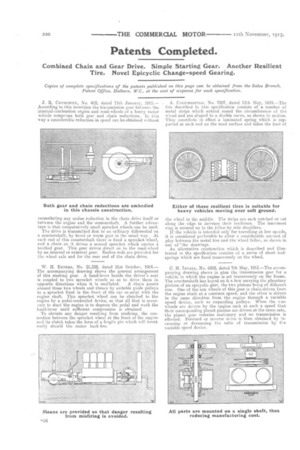Patents Completed.
Page 20

If you've noticed an error in this article please click here to report it so we can fix it.
Combined Chain and Gear Drive. Simple Starting Gear. Another Resilient Tire. Novel Epieyelie Change-speed Gearing.
Copies of complete specifications of the patents published on this page can be obtained from the Saks Branch, Patent Office, Holborn, WC., at the cosi of sixpence for each specification.
J. B. CHURCHILL, No. 418, dated 11th January, 1915.— According to this invention the transmission gear between the internal-combustion engine and road-wheels of a heavy motor vehicle comprises both gear and chain reductions. In this Way a considerable reduction in speed can he obtained without
necessitating any undue reduction in the chain drive itself or between the engine and the countershaft. A further advantage is that comparatively small sprocket wheels can be used.
The drive is transmitted first to an ordinary differential on a countershaft, by bevel or worm gear in the usual way. At each end of this countershaft there is fixed a sprocket wheel, and a chain on it drives a second sprocket. which carries a toothed gear. This -gear drives direct on to the road-wheel by an internal or external gear. Radius rods are provided for the wheel axle and for the rear end of the chain drive.
W. H. ENDERS, No. 21,332, dated 21st October, 1914.-The accompanying drawing shows the general arrangement of this starting gear. A hand-lever beside the driver's seat is coupled to two sprocket wheels so as to drive them in opposite directions when it is oscillated. A chain passes around these two wheels and thence by suitable guide pulleys to a sprocket fixed in the front of the car co axial with the engine shaft. This sprocket wheel can be clutched to the engine by a pedal-controlled device, so that all that is necessary to start the engine is to depress the pedal and work the hand-lever until sufficient compression is obtained To obviate any danger resulting from misfiring, the connection between the sprocket wheel at the front of the engine and its clutch takes the form of a fragile pin which will break easily should the motor back fire. A. CALICHIOPULO, No. 7207, dated 13th May, 19l5.—The tire described in this specification consists of a number of metal strips which extend round the circumference of the wheel and are shaped to a double curve, as shown in section. They constitute in effect a laminated spring which :s supported at each end on the read surface and takes the load of the wheel in the middle. The strips are each notched or cut along the edge to increase their resilience. The innermost ring is secured on to the felloe by side shoulders. If the vehicle is intended only for travelling at low speeds, it is considered preferable to allow a considerable amount of play between the metal tire and the wheel felloe, as shown in one of 'the drawings. An alternative construction which is described and illustrated in the specification ccnsists of a settee of short leafsprings which are fixed transversely on the wheel.
C. H. Iaraaaa, No. 6850, dated 7th May, 1915.—The accompanying drawing shows in plan the transmission gear for a vehicle in which the engine is set transversely on the frame. The countershaft has keyed on it a box carrying the planetary pinions of an epicyclic gear, the two pinions being of different size. One of the sun wheels of this gear is chain-driven from the engine shaft at a constant speed, and the ether is driven. in the same direction from ths engine through a variable speed device, such as expanding pulleys. When the sanwheels are driven by the engine each at such a speed that their corresponding planet pinions are driven, at the same rate, the planet gear remains stationary and no transmission is effected. Forward Or reverse chive is then obtained by increasing or decreasing the ratio of transmission by the .variable speed device.




















